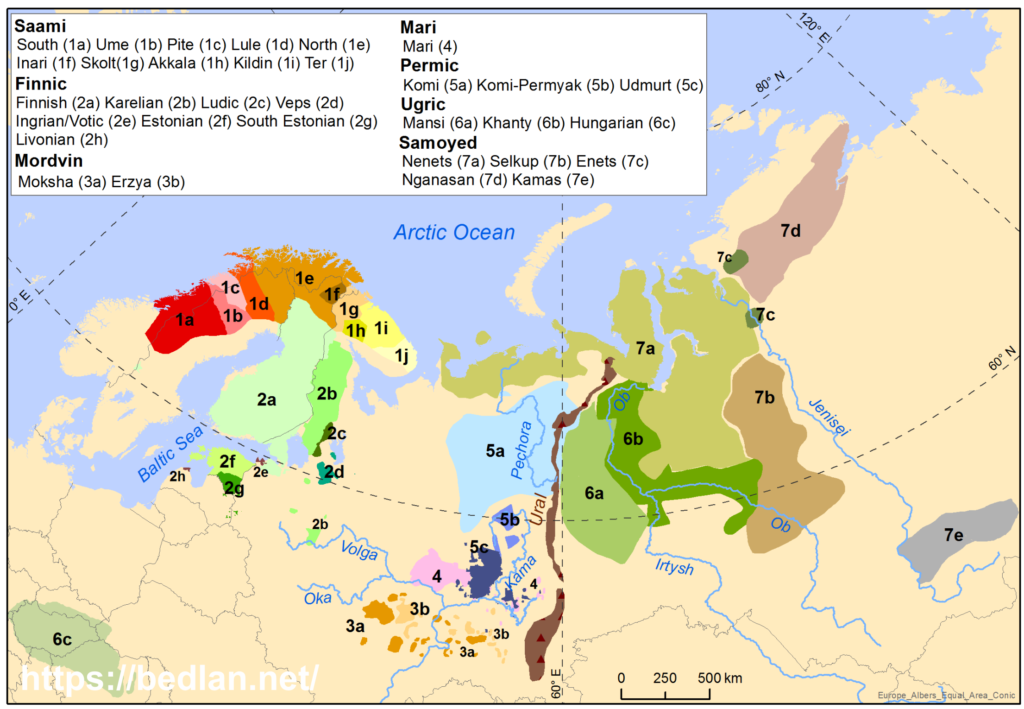The Uralic language family consist of ca. 40 languages spoken in across northeastern Europe and Siberia, with the exception of Hungary, which is spoken in the Central Europe. Finnish, Estonian and Hungarian are the only national languages with millions of speakers, whereas the other languages are spoken as minority languages in the geographical area of Russia, Sweden and Norway. In addition, Livonian and Kamas are now extinct.

It is well-established by traditional linguistic methods that these languages are all descended from a common ancestor, called “proto-Uralic”. However, exactly how long ago proto-Uralic was spoken, and in which parts of the world, is a topic of ongoing research. BEDLAN hopes to use large, multidisciplinary datasets and cutting-edge methods of analysis to help investigate these questions.
See also our page on the Uralic language family and its speaker area.
More Uralic language maps, both modern and historical areas, are also available on the URHIA (Uralic Historical Atlas) project https://sites.utu.fi/urhia/language-maps
Map sources
Saami
Sammallahti, P. 1998. The Saami languages. An Introduction. Kárásjohka, Davvi girji.
Finnic
Finnish, Ludic, Ingrian, Livonian, Estonian, South Estonian, Livonian
Grünthal, R. & Sarhimaa, A. (toim.) 2004/2012. Itämerensuomalaiset kielet ja niiden päämurteet. Suomalais-Ugrilainen Seura.
Karelian
Sarhimaa, A. 2017. Vaietut ja vaiennetut karjalankieliset karjalaiset Suomessa. Suomalaisen Kirjallisuuden Seura. 297 s.
Veps
Tunkelo & Leskinen (toim.) 1946. Vepsäläisten asuinalueet.
Mordvin
Grünthal, R. & Salminen, T. (edit.) 1993. Geographical distribution of the Uralic languages. Finno-Ugrian Society.
Mari
Lytkin, V. I., Maytinskaya, K. E. & Rédei, K. (edit.) 1976. The Fundamentals of Fenno-Ugric Linguistics. The Academy of Sciences of the USSR 3. Moscow, Nauka.
Permic
Komi (Zyrian) & Komi-Permyak
Lytkin, V. I., Maytinskaya, K. E. & Rédei, K. (edit.) 1976. The Fundamentals of Fenno-Ugric Linguistics. The Academy of Sciences of the USSR 3. Moscow, Nauka.
Udmurt
Maksimov, S. 2001. Pohjoisudmurtin murteiden ja komin kielen areaalisia leksikaalisia yhtäläisyyksiä. Suomalais-ugrilaisen seuran aikakauskirja 89. Helsinki.
Ugric
Mansi & Khanty
Lytkin, V. I., Maytinskaya, K. E. & Rédei, K. (edit.) 1976. The Fundamentals of Fenno-Ugric Linguistics. The Academy of Sciences of the USSR 3. Moscow, Nauka.
Hungarian
Jenő Kiss (ed.) 2001, Magyar dialektológia, Osiris, Budapest.
Samoyed
Nenets, Selkup, Enets, Nganasan
Grünthal, R. & Salminen, T. (edit.) 1993. Geographical distribution of the Uralic languages. Finno-Ugrian Society.
Kamas
Dolgix, B. O. 1960. Rodovoj I plemennoj sostav narodov Sibiri v XVII v. Moscow-Leningrad: Akademija Nauk SSSR.
Helimski, E. 1997. Die Matorische Sprache. Wörterverzeichnis – Grundzüge der Grammatik – Sprachgeschichte. Unter Mitarbeit von Beáta Nagy. SUA 41. Szeged: JATE Finnougor tanszék.

